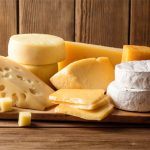 A food made from mammal’s milk. There are many types of cheeses depending on the amount of moisture, extent of ripening, how it is fermented, and how it is eaten.
A food made from mammal’s milk. There are many types of cheeses depending on the amount of moisture, extent of ripening, how it is fermented, and how it is eaten.
In the early nineteenth century, it became something of an American custom to honour the president on special occasions by presenting him with a large wheel of cheese. For instance, Thomas Jefferson was given a 1200-pound cheese on New Year’s day in 1802. Even more gargantuan was the 1400-pound wheel of cheese presented to Andrew Jackson in 1837 on the occasion of his last official reception at the White House; unfortunately, the combination of the 1400-pound chunk of cheese and almost 10,000 schmoozing well-wishers resulted in about a 100,000 cheese crumbs being ground into carpets, dropped into sofas, and hidden in flower pots. When it was over, the White House had been turned upside-down, and the odour of this cheesy saturnalia lingered in the president’s home for weeks. This historical association of huge wheels of cheese and presidents might suggest a plausible origin for the expression the big cheese, a term that emerged early in the twentieth century to mean the person in charge. In fact, however, the cheese in the big cheese has nothing to do with the dairy product. Instead, the cheese in the big cheese derives from the Hindi word chiz, meaning thing, a usage parallel to English expressions like “She really thinks she’s something.” The dairy cheese, on the other hand, was first recorded in English about a thousand years ago and derives from the Latin name for cheese, caseus. This Latin name may in turn have evolved from the Sanskrit word kvathati, meaning he boils, the connection being that milk will bubble and froth before it turns into cheese.
